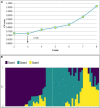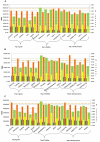Nitrogen Use Efficiency in Sorghum: Exploring Native Variability for Traits Under Variable N-Regimes
- PMID: 33968102
- PMCID: PMC8097177
- DOI: 10.3389/fpls.2021.643192
Nitrogen Use Efficiency in Sorghum: Exploring Native Variability for Traits Under Variable N-Regimes
Abstract
Exploring the natural genetic variability and its exploitation for improved Nitrogen Use Efficiency (NUE) in sorghum is one of the primary goals in the modern crop improvement programs. The integrated strategies include high-throughput phenotyping, next generation sequencing (NGS)-based genotyping technologies, and a priori selected candidate gene studies that help understand the detailed physiological and molecular mechanisms underpinning this complex trait. A set of sixty diverse sorghum genotypes was evaluated for different vegetative, reproductive, and yield traits related to NUE in the field (under three N regimes) for two seasons. Significant variations for different yield and related traits under 0 and 50% N confirmed the availability of native genetic variability in sorghum under low N regimes. Sorghum genotypes with distinct genetic background had interestingly similar NUE associated traits. The Genotyping-By-Sequencing based SNPs (>89 K) were used to study the population structure, and phylogenetic groupings identified three distinct groups. The information of grain N and stalk N content of the individuals covered on the phylogenetic groups indicated randomness in the distribution for adaptation under variable N regimes. This study identified promising sorghum genotypes with consistent performance under varying environments, with buffer capacity for yield under low N conditions. We also report better performing genotypes for varied production use-grain, stover, and dual-purpose sorghum having differential adaptation response to NUE traits. Expression profiling of NUE associated genes in shoot and root tissues of contrasting lines (PVK801 and HDW703) grown in varying N conditions revealed interesting outcomes. Root tissues of contrasting lines exhibited differential expression profiles for transporter genes [ammonium transporter (SbAMT), nitrate transporters (SbNRT)]; primary assimilatory (glutamine synthetase (SbGS), glutamate synthase (SbGOGAT[NADH], SbGOGAT[Fd]), assimilatory genes [nitrite reductase (SbNiR[NADH]3)]; and amino acid biosynthesis associated gene [glutamate dehydrogenase (SbGDH)]. Identification and expression profiling of contrasting sorghum genotypes in varying N dosages will provide new information to understand the response of NUE genes toward adaptation to the differential N regimes in sorghum. High NUE genotypes identified from this study could be potential candidates for in-depth molecular analysis and contribute toward the development of N efficient sorghum cultivars.
Keywords: N content; NUE; expression analysis; genetic variability; sorghum.
Copyright © 2021 Bollam, Romana, Rayaprolu, Vemula, Das, Rathore, Gandham, Chander, Deshpande and Gupta.
Conflict of interest statement
The authors declare that the research was conducted in the absence of any commercial or financial relationships that could be construed as a potential conflict of interest.
Figures




 GY (g): Grain yield (g);
GY (g): Grain yield (g); DSY (g): Dry stak yield (g);
DSY (g): Dry stak yield (g);  GN%: N content in grain;
GN%: N content in grain;  SN%: N content in stak].
SN%: N content in stak].


Similar articles
-
Root-associated bacterial communities and root metabolite composition are linked to nitrogen use efficiency in sorghum.mSystems. 2024 Jan 23;9(1):e0119023. doi: 10.1128/msystems.01190-23. Epub 2023 Dec 22. mSystems. 2024. PMID: 38132569 Free PMC article.
-
Enhancing Sorghum Yield Through Efficient Use of Nitrogen - Challenges and Opportunities.Front Plant Sci. 2022 Feb 28;13:845443. doi: 10.3389/fpls.2022.845443. eCollection 2022. Front Plant Sci. 2022. PMID: 35295626 Free PMC article. Review.
-
Nitrogen Use Efficiency in Durum Wheat Under Different Nitrogen and Water Regimes in the Mediterranean Basin.Front Plant Sci. 2021 Feb 10;11:607226. doi: 10.3389/fpls.2020.607226. eCollection 2020. Front Plant Sci. 2021. PMID: 33643329 Free PMC article.
-
Validation of QTL mapping and transcriptome profiling for identification of candidate genes associated with nitrogen stress tolerance in sorghum.BMC Plant Biol. 2017 Jul 11;17(1):123. doi: 10.1186/s12870-017-1064-9. BMC Plant Biol. 2017. PMID: 28697783 Free PMC article.
-
Nitrogen use efficiency (NUE): elucidated mechanisms, mapped genes and gene networks in maize (Zea mays L.).Physiol Mol Biol Plants. 2021 Dec;27(12):2875-2891. doi: 10.1007/s12298-021-01113-z. Epub 2021 Dec 22. Physiol Mol Biol Plants. 2021. PMID: 35035142 Free PMC article. Review.
Cited by
-
Integrative physiological and transcriptome analysis unravels the mechanism of low nitrogen use efficiency in burley tobacco.Plant Direct. 2024 Oct 20;8(10):e70004. doi: 10.1002/pld3.70004. eCollection 2024 Oct. Plant Direct. 2024. PMID: 39435449 Free PMC article.
-
Root-associated bacterial communities and root metabolite composition are linked to nitrogen use efficiency in sorghum.mSystems. 2024 Jan 23;9(1):e0119023. doi: 10.1128/msystems.01190-23. Epub 2023 Dec 22. mSystems. 2024. PMID: 38132569 Free PMC article.
-
Mapping and Screening of Candidate Gene Regulating the Biomass Yield of Sorghum (Sorghum bicolor L.).Int J Mol Sci. 2024 Jan 8;25(2):796. doi: 10.3390/ijms25020796. Int J Mol Sci. 2024. PMID: 38255870 Free PMC article.
-
Comparison of Mutations Induced by Different Doses of Fast-Neutron Irradiation in the M1 Generation of Sorghum (Sorghum bicolor).Genes (Basel). 2024 Jul 24;15(8):976. doi: 10.3390/genes15080976. Genes (Basel). 2024. PMID: 39202337 Free PMC article.
-
Enhancing Sorghum Yield Through Efficient Use of Nitrogen - Challenges and Opportunities.Front Plant Sci. 2022 Feb 28;13:845443. doi: 10.3389/fpls.2022.845443. eCollection 2022. Front Plant Sci. 2022. PMID: 35295626 Free PMC article. Review.
References
-
- Achakzai A. K. K., Rajpar H., Shah B. H., Wahid M. A. (2012). Effect of nitrogen fertilizer on the growth of mungbean [Vigna radiata (L.) Wilczek] grown in Quetta. Pakistan J. Bot. 44 981–987.
-
- Ajeigbe H. A., Akinseye F. M., Ayuba K., Jonah J. (2018). Productivity and Water Use Efficiency of Sorghum [Sorghum bicolor (L.) Moench] Grown under Different Nitrogen Applications in Sudan Savanna Zone, Nigeria. Int. J. Agron. 2018:20767605818. 10.1155/2018/7676058 - DOI
-
- Al Salameen F., Habibi N., Al Amad S., Kumar V., Dashti J., Talebi L., et al. (2020). Genetic diversity analysis of Rhanterium eppaposum Oliv. by ISSRs reveals a weak population structure. Curr. Plant Biol. 21:100138. 10.1016/j.cpb.2020.100138 - DOI
LinkOut - more resources
Full Text Sources
Other Literature Sources

